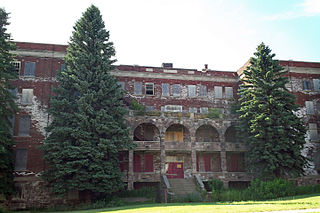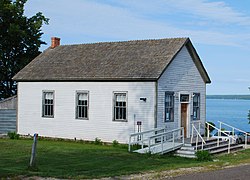
Baraga County is a county in the Upper Peninsula in the U.S. state of Michigan. As of the 2020 census, the population was 8,158, making it Michigan's fifth-least populous county. The county seat is L'Anse. The county is named after Bishop Frederic Baraga, a Catholic missionary who ministered to the Ojibwa Indians in the Michigan Territory.

Baraga Township is a civil township of Baraga County in the U.S. state of Michigan. As of the 2020 census, the township population was 3,478. The village of Baraga is located in the southeast corner of the township.

L'Anse Township is a civil township of Baraga County in the U.S. state of Michigan. As of the 2020 census, the township population was 3,551. The township contains Mount Arvon and Mount Curwood, Michigans highest and second-highest points, as well as the village of L'Anse.

The L'Anse Indian Reservation is the land base of the federally recognized Keweenaw Bay Indian Community of the historic Lake Superior Band of Chippewa Indians.. The reservation is located primarily in two non-contiguous sections on either side of the Keweenaw Bay in Baraga County in the Upper Peninsula of the U.S. state of Michigan. The Keweenaw Bay Community also manages the separate Ontonagon Indian Reservation.

Irenaeus Frederic Baraga was a Slovenian Roman Catholic missionary to the United States and a grammarian by and author of Christian poetry and hymns in Native American languages. He became the first bishop of the Roman Catholic Diocese of Marquette, Michigan, originally sited at Sault Sainte Marie, which he led for 15 years.

The Sault Ste. Marie Tribe of Chippewa Indians, commonly shortened to Sault Tribe of Chippewa Indians or the more colloquial Soo Tribe, is a federally recognized Native American tribe in what is now known as Michigan's Upper Peninsula. The tribal headquarters is located within Sault Ste. Marie, the major city in the region, which is located on the St. Marys River.

The Diocese of Marquette is a Latin Church ecclesiastical territory, or diocese, of the Catholic Church, encompassing the Upper Peninsula region of Michigan in the United States. The diocese is a suffragan diocese in the ecclesiastical province of the metropolitan Archdiocese of Detroit. Its cathedral is St. Peter Cathedral in Marquette, which replaced Holy Name of Mary Pro-Cathedral at Sault Ste. Marie.

St. Peter Cathedral is a large Roman Catholic cathedral located on Baraga Avenue in Marquette, Michigan. As the mother church of the Diocese of Marquette, it is one of the most notable marks of Catholic presence in the Upper Peninsula. The cathedral was listed on the National Register of Historic Places in 2012.

Zeba is an unincorporated community and census-designated place (CDP) in Baraga County in the U.S. state of Michigan. The CDP had a population of 397 at the 2020 census. The community is located near the southern end of the Keweenaw Bay just north of the village of L'Anse within L'Anse Township.

Church of Our Saviour, Friend of Children, also known as Holy Angels Roman Catholic Church, is a church located on North Shore Road on Sugar Island, near Sault Ste. Marie, Michigan. It was designated a Michigan State Historic Site in 1978 and listed on the National Register of Historic Places in 1982.

Holy Redeemer Church is an historic Carpenter Gothic style Roman Catholic church located at the west end of Center Street in Eagle Harbor, Michigan. It was designated a Michigan State Historic Site in 1958 and listed on the National Register of Historic Places in 1972.

Saint Ignatius Loyola Church is a church located at 703 East Houghton Avenue in Houghton, Michigan. The church was designated a Michigan State Historic Site in 1977 and listed on the National Register of Historic Places in 1987.

Old St. Ferdinand Shrine and Historic Site is located at no. 1 rue St. Francois, Florissant, Missouri, and is owned, preserved, maintained, and protected by the non-profit organization, Friends of Old St. Ferdinand, Inc. The Shrine and Historic Site consists of four historic buildings on their original locations: the 1819 convent, 1821 church, 1840 rectory, and 1888 schoolhouse.

Holy Name of Mary Proto-Cathedral, also known as St. Mary Proto-Cathedral, is a historic Roman Catholic parish church in Sault Ste. Marie, Michigan, United States, that was formerly a cathedral church and the first cathedral, hence "proto-cathedral", of the Roman Catholic Diocese of Marquette. It is the oldest parish and oldest cathedral parish in Michigan, and the third oldest parish in the United States. While the present church edifice, the fifth for the parish, dates from 1881, the parish began in 1668 as a Jesuit mission. It was listed on the National Register of Historic Places in 1984 and designated a State of Michigan historic site in 1989. The proto-cathedral was the (first) cathedral of the Diocese of Marquette when it was denominated the "Diocese of Sault Sainte Marie", which diocesan title is presently that of a titular episcopal see.

The Zeba Indian United Methodist Church is a religious building located at 227 Front Street in Zeba, Michigan, northeast of L'Anse. It marks the site of the Kewawenon Mission, built in 1832, which was the birthplace of Indian Methodism in the western Upper Peninsula, and predated Frederic Baraga's mission at Assinins by 11 years. It was listed on the National Register of Historic Places in 1980 and designated a Michigan State Historic Site in 1979.

St. Francis Solanus Mission is a historic mission on W. Lake Street in Petoskey, Michigan. It is the only existing building in the Arbre Croche district dating from the time of Bishop Frederic Baraga, and is the oldest building still standing in Petoskey, as well as one of the oldest in northern lower Michigan. The mission was added to the National Register of Historic Places in 1972.

Saint Joseph's Catholic Church is a church located at 5899 County Road 669 near Maple City, Michigan and east of Glen Arbor, Michigan. It was constructed in 1884 and listed on the National Register of Historic Places in 1992.

La Pointe Indian Cemetery is the common name of the St. Joseph Mission Cemetery, located on Madeline Island in La Pointe, Wisconsin. It was added to the National Register of Historic Places in 1977. It is a frequently visited historical site.
St. Mary's Church, School and Convent is a historic Roman Catholic church complex off United States Route 212 in Zell, South Dakota.

Holy Family Orphanage was an abandoned Catholic orphanage located at 600 Altamont Street in Marquette, Michigan. It was listed on the National Register of Historic Places on October 5, 2015.
























